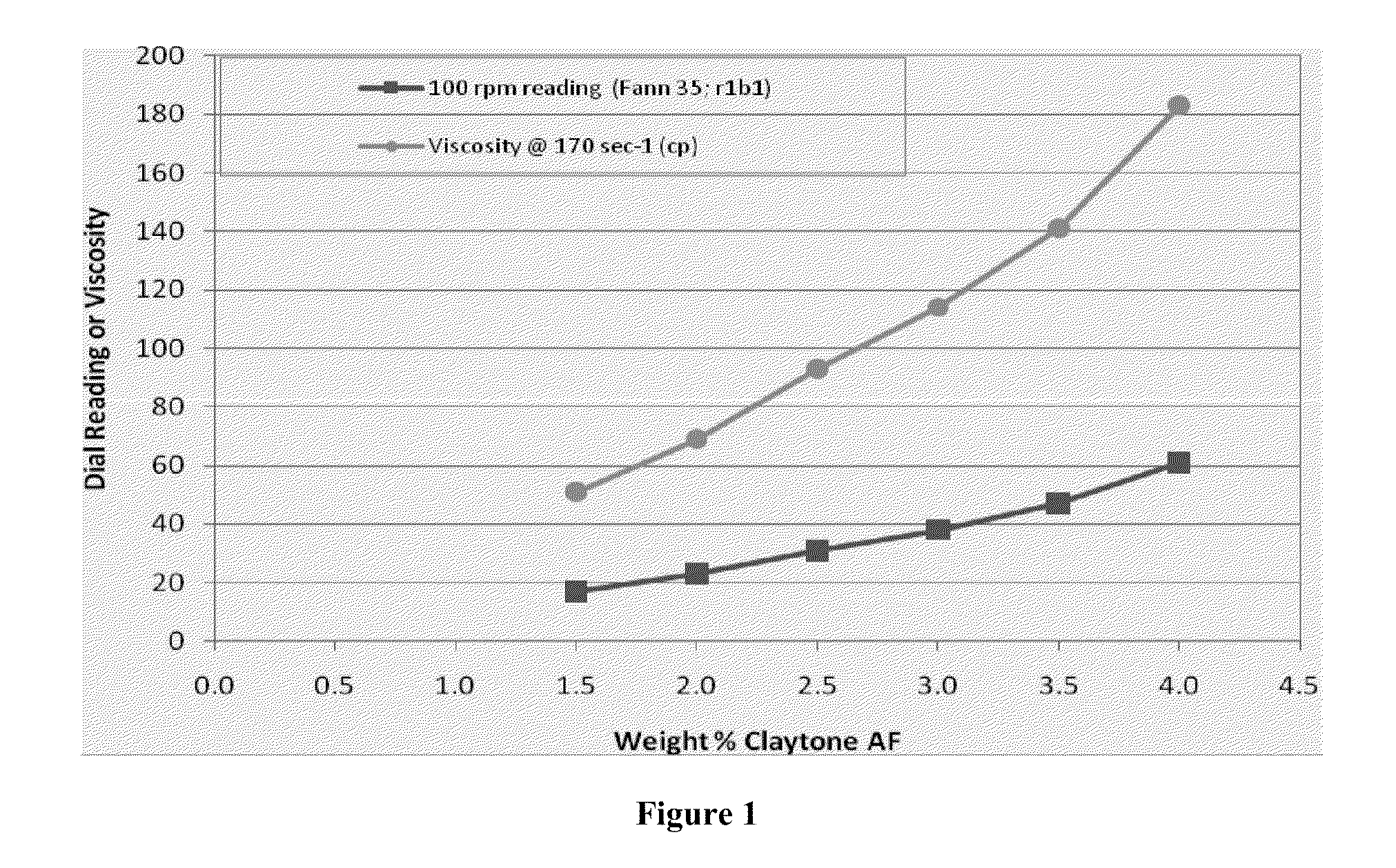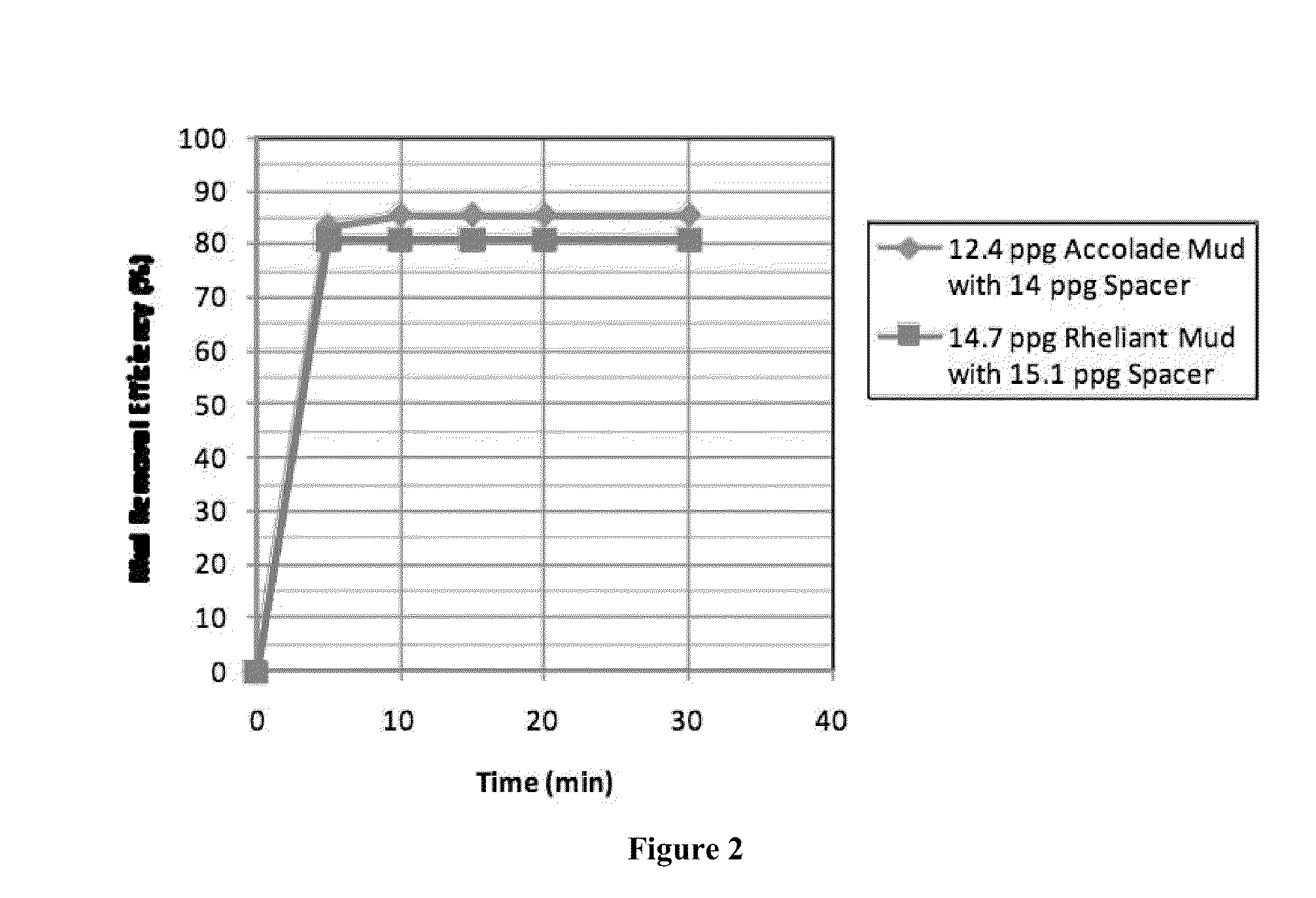Compositions and metods for cleaning a wellbore prior to cementing
a technology of cementing and composition, applied in the direction of fluid removal, wellbore/well accessories, chemistry apparatus and processes, etc., can solve the problems of poor oil-wet wellbore, and poor cement bonding between the cement set and the casing and wellbore surfaces, etc., to achieve the effect of superior cement bonding
- Summary
- Abstract
- Description
- Claims
- Application Information
AI Technical Summary
Benefits of technology
Problems solved by technology
Method used
Image
Examples
example 1
Compatibility
[0063]The 14.0-lbm / gal (1.68-kg / L) microemulsion-base spacer formulation showed R-values of 15 and 23 with the ACCOLADE mud and cement slurry, respectively. These values indicated that the fluids were compatible, but friction pressures should be checked during job design.
[0064]Cement-compatibility tests with the 15.5-lbm / gal (1.89-kg / L) microemulsion-base spacer provided an R-value of 68, indicating a slight incompatibility, and a need for the spacer formulation to be redesigned. The Claytone AF gelling-agent concentration was decreased from 2.5% to 2.1% by weight of the base fluid, and the density was lowered to 15.1 lbm / gal (1.81 kg / m3). The results indicated R-values of 6.5 and 23.5 for the spacer / RHELIANT mud and spacer / cement slurry, respectively, indicating fluid compatibility. This also demonstrated that the gelling agent and density may be modified in order to improve the compatibility of the spacer formulation with both the mud and cement (Table 8).
TABLE 8R-Ind...
example 2
Casing Water-Wetting
[0065]Casing water wetting was evaluated, and the results are tabulated in Table 9. The results show that the microemulsion-base spacer formulation provided good water-wetting properties (as demonstrated by contact angles of 15° and 23°) while cleaning both the RHELIANT and ACCOLADE mud from the casing coupons.
TABLE 9Casing Water Wetting ResultsMeasured Diameter, cm (Using Ruler)14 lbm / gal Microemulsion-15.1 lbm / gal Microemulsion-based spacer w / 12.4 lbm / galbased spacer w / 14.7 lbm / gal(1.49 kg / L) ACCOLADE Mud(1.76 kg / L) RHELIANT MudWater Droplet on0.40.4Teflon, D1Droplet on Treated0.91.2Side, D2Diameter Ratio, 2.25 3.00D2 / D1Contact Angle26°15°ResultWater-WettabilityGood WettingGood WettingResult
example 3
Grid Cleaning
[0066]The results of the grid tests are provided in Table 10 and FIG. 2 and show mud removal efficiency of 85% with the Accolade mud and 81% for the RHELIANT mud. Most of the mud was removed within about 5 min.
TABLE 10Grid Test ResultsSynthetic DrillingMud Removal,Spacer FormulationMudMR (%)14.0-lbm / gal (1.68-kg / L)12.4 lbm / gal (1.4985Microemulsion-base Spacerkg / L) ACCOLADE15.1-lbm / gal (1.81-kg / L)14.7 lbm / gal (1.7681Microemulsion-base Spacerkg / L) RHELIANT
PUM
 Login to View More
Login to View More Abstract
Description
Claims
Application Information
 Login to View More
Login to View More - R&D
- Intellectual Property
- Life Sciences
- Materials
- Tech Scout
- Unparalleled Data Quality
- Higher Quality Content
- 60% Fewer Hallucinations
Browse by: Latest US Patents, China's latest patents, Technical Efficacy Thesaurus, Application Domain, Technology Topic, Popular Technical Reports.
© 2025 PatSnap. All rights reserved.Legal|Privacy policy|Modern Slavery Act Transparency Statement|Sitemap|About US| Contact US: help@patsnap.com



